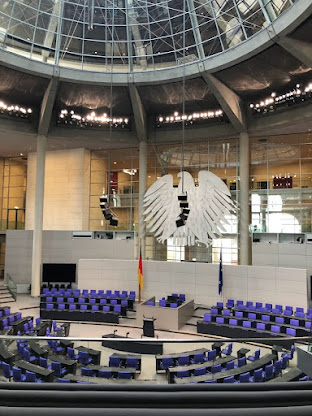Blocker Blog - Entry 2: First Impressions of the Museuminsel
After a couple of weeks
exploring the streets of Berlin, I have had a chance to get a first impression
of the museums at the center of Berlin, Museum Island, otherwise known as Museuminsel.
Even though I had previous knowledge about one of the institutions of the
island, the Humboldt Forum, I knew nothing about the other museums. Starting
from the north of the island, the museums consist of the Bode-Museum,
Pergamonmuseum, Neues Museum, Alte Nationalgalerie, James-Simon-Galerie, Altes
Museum, and finally the Humboldt Forum. There are other museums and galleries
around the island but for the moment, I will talk about these main institutions
for now.
The Humboldt Forum,
as previously stated, was where the Schloss Palace use to stand, which was were
Prussian monarchs would live during the days of the Prussian Empire. Upon the
German unification and during the First World War, the palace stood where the
Keiser lived; it was then almost completely destroyed in the aftermath of WWII ,
where the Soviets, who claimed the entirety of the island to be part of East
Berlin, used the space to build Palast der Republik, where the Parliament
of East Germany would be hosted. Upon the second German unification and the fall
of the Soviet Union, the Palast der Republik was destroyed. For the
future of the space, it was debated what it would be used for. After 30 years
the forum was built, with there being a collection of artefacts with origins from
the Americas, Africa, Oceania, and Asia.
With such loaded
History that the space has, what gets people critical of the Forum would the imperial
weight that the design of the institution has and its history of acquiring most
if not all of the artefacts of the collection. The words that I associate with
this history would be looting, robbing, and sabotage. However, the institution itself
does hold conversations to be had about this history, which ranges from educating
the public of history from reflecting upon objects that have been repatriated,
such as the Benin Bronzes. My first thoughts upon all of this would be
appreciation for allowing conversations around this heavy and negative legacy.
However, upon the following months of my stay, I hope to expand my thoughts
upon this practice by analyzing how the Forum shows, explains and reflect on all
of its artefacts.





Comments
Post a Comment